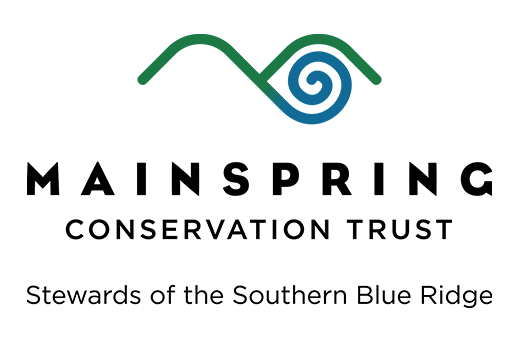Cowee Floodplain Protected
LTLT Conserves Another 900’ of Little Tennessee River
Fronting the Cowee Mound
Franklin, NC The Land Trust for the Little Tennessee (LTLT) conserved another key parcel along the Little Tennessee River when it purchased 3.1 acres lying between NC Highway 28 and the river. While the property had been marketed as nine, riverfront RV lots in recent years, the low-lying floodplain property was not well suited for this use. The parcel encompasses 900’ of river frontage at the foot of Pott’s Branch, and it lies directly across the river from the Cowee Mound and immediately downstream from another 16-acre parcel previously conserved by LTLT.
In early 2007 the Cowee Mound was protected by LTLT in partnership with the Eastern Band of Cherokee Indians and the State of North Carolina. “This is a great acquisition that will support a community vision of heritage-based development in this historic landscape,” said LTLT’s Sharon Fouts Taylor. “This parcel offers the best view of the Cowee Mound from Highway 28, and with some modest investment it can provide a safe place for people to pull of the highway, park, and view the River and the Mound.”

The ancient Cowee Mound was at the heart of the principal commercial and diplomatic town of the mountain Cherokee in the decades leading up to the American Revolution. When William Bartram visited Cowee in the spring of 1775 he described a council house on the Mound that seated hundreds of residents. In the mid-18th century Cowee was at the geopolitical center of the South when first British Imperial and then Colonial ambitions clashed with those of the native people, in part to control the principal trade route through the southern mountains into the interior of the continent.
An 1837 map of Cowee shows a bridge crossing the river at the site of LTLT’s new purchase. “When the river was low during the severe drought two years ago, large squared boulders that must have buttressed that bridge were clearly evident in the river channel between this parcel and the Mound on the opposite bank,” commented Paul Carlson, LTLT’s Executive Director. “This parcel allows us to protect and restore a small area of bottomland forest and riverbank while it also can serve as an important interpretative site in conjunction with the Cowee-Wests Mill Historic District. The Little Tennessee River and the largely-intact historic landscape of northern Macon County are the greatest local assets we have for future economic development as well as for enhancing the fine quality of life we enjoy in this area.”
This purchase was made possible by a gift from Fred and Alice Stanback of Salisbury, NC who were key philanthropists in the purchase of the Needmore Tract in 2004. Apart from the 4600-acre Needmore Tract, LTLT has now completed 20 land conservation projects along the Little Tennessee River downstream of Franklin. In the past 9 years over two-thirds (32 miles) of the river frontage has been conserved along this magnificent reach of river which arguably encompasses the richest and most intact combination of cultural and natural history of any area of similar size in the nation.
Tessentee Addition
LTLT Adds to Tessentee Bottomland Preserve
A bargain sale by Margaret Parks, in honor of her late husband, James (Jim) Parks, Jr., will allow the Land Trust for the Little Tennessee (LTLT) to add another 5.6 acres to its Tessentee Bottomland Preserve. Parks sold the property to LTLT for less than one-half of its market value and financed one-half of the purchase price to allow LTLT time to raise funds for the project. LTLT acquired the original 64-acre tract of bottomland and river bluff at the junction of Tessentee Creek and the Little Tennessee River in 1999 and 2000. The ecologically diverse Tessentee Preserve encompasses habitat types which one would more likely find in the Mississippi Valley than in the mountains of Western North Carolina, including wetland, red cedar savannah, canebrakes, and yellow pine/blackjack oak forest. The Parks property will add yet another unique habitat to Tessentee Preserve.
The Parks addition includes a large granite outcropping overlooking Tessentee Creek which contains a distinctive habitat with a profusion of plant life. It also commands a sweeping view of the broad Little Tennessee valley looking south towards Rabun Gap, Georgia. The outcropping is said to have served as a “lookout” for the Cherokee and could have provided the vantage point on June 27, 1760 as the British and Colonial forces marched on the Middle Cherokee towns in the first battle of the “Cherokee Wars”. That battle, which may have taken place on the bottomlands of the Tessentee Preserve, saw sixteen “Redcoats” and thirteen “Provincials” slain and seventy-six wounded in an ambush by the Cherokee.
After the Parks bought the property, which lies on the eastern boundary of The Tessentee Bottomland Preserve, Jim took a special interest in the land and spent many happy hours working and enjoying the woods. “Jim removed the dead pines after the pine beetle infestation and replaced them with oaks, redbud, hemlock, and other native species,” Margaret said. They both enjoyed the many “treasures” of the woods, including the wildflowers, blueberries and wildlife. “I once came upon a baby deer in the clearing, just lying there sleeping,” she recalled. “There were many animals making their home there, including an albino skunk.” The plentiful flora and fauna enjoyed by the Parks is due to an abundance of water resources and the diverse habitats created by the different soil types in the area. The original Tessentee Bottomland Preserve contains nine soil types making it an extraordinary place for viewing wildlife. The Preserve’s bird list stands at 115 species and butterfly list at 42 species – and counting. Tessentee Bottomland Preserve is open to the public and is stop #53 on the NC Birding Trail.
LTLT’s Executive Director, Paul Carlson, says that “LTLT is excited to expand Tessentee Bottomland Preserve to provide an even more enriching experience for the public and is honored to partner with Mrs. Parks to fulfill her late husband’s dream of conserving the land”. “Jim kept every LTLT brochure and newsletter from the beginning of its history”, Margaret Parks said. “Conserving the property with LTLT is a way of fulfilling his longtime interest”.


